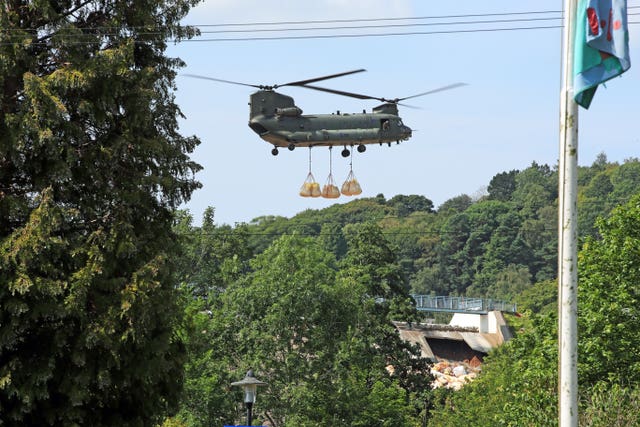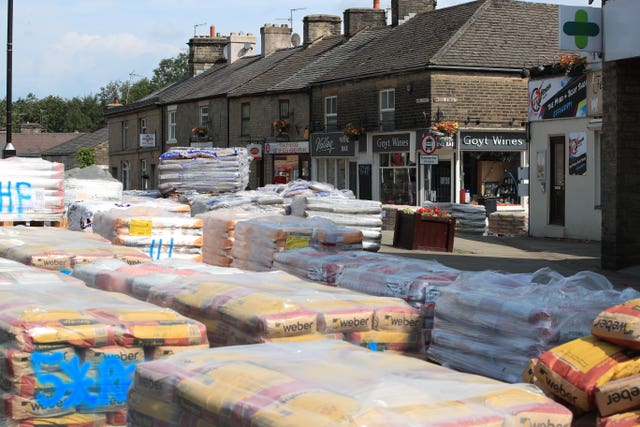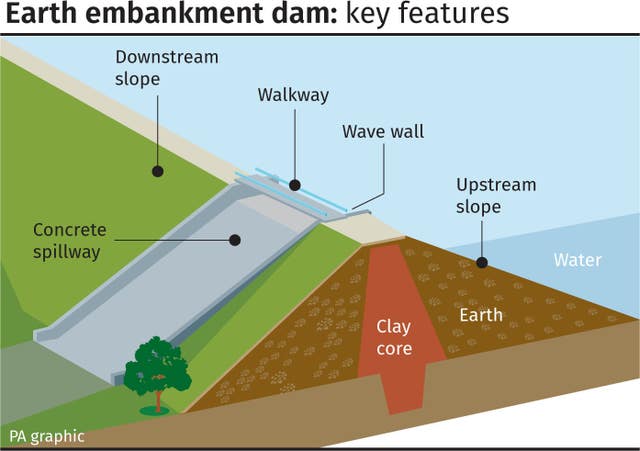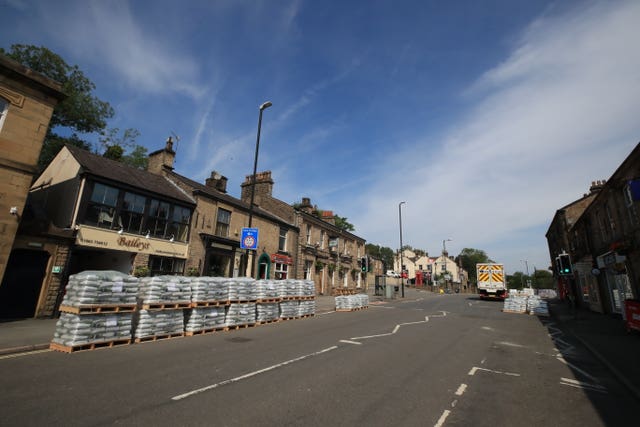
More people are being evacuated from their homes in Derbyshire amid fears a damaged dam could collapse as further bad weather is forecast.
Fifty-five homes in the Horwich End, Whaley Bridge area were being cleared on Saturday evening, two days after around 1,500 residents were evacuated.
Water levels at the Toddbrook Reservoir in Whaley Bridge have been reduced by 1.3 metres since Thursday but the damage to the 180-year-old structure remains at a “critical level”.
Police said the added evacuations were due to “a potential increase in risk of adverse weather in coming days and the ongoing risk of the Toddbrook Reservoir breaching”.
Evacuated residents have been allowed briefly back to their homes this weekend, but warned they would be doing so at their own risk, as emergency services continued their efforts to prevent the dam collapsing.
A map of houses that have been evacuated from the Horwich End area of #WhaleyBridge has been produced: pic.twitter.com/YczP91VfIK
— Derbyshire Police (@DerbysPolice) August 3, 2019
The Government warned there was still a threat to life in the town ahead of more bad weather on Sunday, when a Met Office yellow weather warning is in place for much of northern England and the Midlands, including the area around the reservoir.
Chief Superintendent Michelle Shooter said: “Officers today have been confronted at cordons by residents wishing to return for issues which are deemed non-essential.
“Evacuation of people from their homes, was a decision which was not taken lightly but has been done to offer maximum safety should we see a breach of the dam”.
Police officers signed people in and out of Buxton Road as they drove through a roadblock to return home.

Joan Pass, 78, was in tears after she went back for the first time since the mass evacuation of the town.
She said: “It was terrible. The helicopter was coming over. You see pictures on the television but when you come home it all seems real.”
Mrs Pass, whose daughter’s home was damaged by flooding in nearby Kettleshulme on Wednesday, said she had to get out of her home within about 10 minutes when the alarm was raised.
She said: “The bells were ringing, I didn’t know what the bells were ringing for, my daughter said get out, get your passport and your medication.
“I thought it was a bomb.”

Ben Pudsey and Andrew McNair, from Animal Search UK, said they had rescued a cockatiel called Joey from one of the evacuated houses, where he had escaped from his cage and was flying around the living room.
Tracey Coleman, who was returning to her home just outside the road closures in the area, said she, her 18-year-old daughter Anna and the rest of the family left on Thursday with their two dogs, a cat, a tortoise and the neighbour’s dog and went to her mother’s house nearby.
She said: “We just took some medication, the animals and a bit of food.”

Deputy Chief Fire Officer of Derbyshire Fire and Rescue Service Gavin Tomlinson said crews had worked through the night to build pumps to lower the water level of the reservoir.
He said: “We are hoping the weather will be kind to us, but everyone is working as hard as possible to get ahead of the curve and remove as much water as possible today, overnight and into tomorrow, to minimise the impact of any bad weather that does materialise.”
Labour MP for High Peak Ruth George said she had written to Prime Minister Boris Johnson, who visited the area on Friday, telling him the town “needs to be able to feel safe and we need to know what the options are”.

Mr Johnson promised that the damaged reservoir would have a “major rebuild” as he met locals at nearby Chapel-en-le-Frith High School, which is being used as an evacuation centre, on Friday.
Describing the damage to the dam as “pretty scary”, he said: “The plan is to try and stop the dam breaking, clearly. And so a huge amount of effort is going into that.”
An RAF Chinook and around 150 firefighters using high-volume pumps appear to have partly stabilised the reservoir’s spillway, with further pumps brought in by officials on Friday.

Environment minister Therese Coffey warned that the situation remained in a “critical stage” on Saturday as she issued a message to residents, and new Environment Secretary Theresa Villiers visited the area where she paid tribute to the “patience and fortitude” of residents.
The reservoir is on the north-west edge of the Peak District National Park and was built in 1831, according to experts, although the Environment Agency records it as being built in 1840-41.


Comments: Our rules
We want our comments to be a lively and valuable part of our community - a place where readers can debate and engage with the most important local issues. The ability to comment on our stories is a privilege, not a right, however, and that privilege may be withdrawn if it is abused or misused.
Please report any comments that break our rules.
Read the rules here